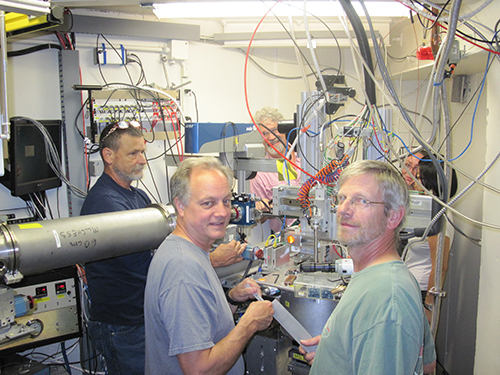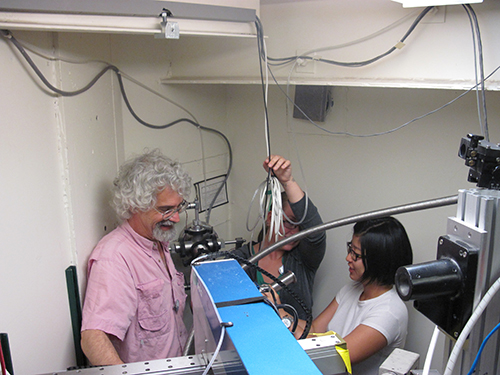X-RAY RUNS: Apply for Beamtime
2017 Nov 1 - Dec 21
2018 Feb 7 - Apr 3
2018 Proposal/BTR deadline: 12/1/17
2018 Apr 11 - Jun 4
2018 Proposal/BTR deadline: 2/1/18
Not many summer students can say they have configured hutches, built beamlines, and spent all night in the lab running experiments and collecting data. But for Gabrielle Long and Yuexia ‘Luna’ Lin, two research students working at CHESS this summer, the opportunity arose midway through their third week on the job. It is rare for students to have the chance to dismantle and build a beamline, and is definitely worth putting their personal research on hold for a weekend, reflected Richard Gillilan, one of Luna and Gabrielle’s advisers. The students worked with Richard and staff members Mike Cook, Scott Smith, and Bill Miller to transition the F1 hutch from a crystallography station to a BioSAXS station.

Temporary conversion of F1 Station to BioSAXS: MacCHESS technicians mount front-end beam pipe and sample stage (left to right front: Mike Cook, Bill Miller, Scott Smith). Staff scientist Richard Gillilan (left rear) and students Gabrielle Long (middle rear), and Luna (Yuexia) Lin assemble and align vacuum window, rear slits, shutter, and beam pipe.
In what Richard referred to as a “marathon through the weekend,” Gabrielle and Luna populated the optical table, helped assemble new parts, aligned cameras, set up motors, pumps and sample cells, created a high vacuum, and aligned the beam on the beam stop at the F1 station. The project began Saturday morning, June 21 and continued through Tuesday, June 24. In order to use F1 in the fall for a BioSAXS Essentials training workshop, MacCHESS scientists needed to prove that the station could be converted to BioSAXS and made easy enough for outside students use. Both students spent late nights at the station, working as a team to help this transition. After it was transformed into a BioSAXS station and test data were gathered, F1 was turned over to an external user, Jesse Hopkins (Cornell) for some last-minute, early morning experiments. Once finished, staff helped transition the hutch back to a crystallography station.
For Luna, an REU theorist who mainly works with equations and simulations, the experience allowed her to see the theory that she studies in application, and changed her mind about hands-on research: “Before working on the F1 hutch I wasn’t interested in experimental physics. But I really enjoyed the problem-solving and collaboration necessary to fix issues as they came up. Now I’m definitely more interested in experimental research.” In addition to configuring a new CLASSE data processing computer, running software, and archiving data, Luna helped assemble parts for the new BioSAXS station.
Gabrielle, a Summer Research for Community College Students (SRCCS) experimentalist accustomed to fabrication and working with hardware, also enjoyed the work. “I can’t believe they’re letting me do this!” she exclaimed when relating her experience about working on the beamline, “I’m still in awe of the amazing science that is happening, and feel so lucky to be able to contribute to it.” She most clearly remembers creating the end vacuum window for F1: using a metal disc and epoxy, Gabrielle secured a thin layer of Mylar to the end of the device. She also helped align the beam with the apparatus and assembled several components for the machine.

Back of F1 hutch during assembly and alignment phase of BioSAXS conversion. Staff scientist Richard Gillilan inspects vacuum window and shutter assembly while students Gabrielle Long (middle) and Luna (Yuexia) Lin (right) position a KF40 vacuum component.
As the F1 run wrapped up, help was needed over in G-line. Positron troubles earlier in the run had offset several users by a week; consequently, the G1 beamline needed to be re-configured immediately for BioSAXS use to allow users to run their experiments. Without time for a break, Luna and Gabrielle volunteered to help Richard and Alvin Acerbo (MacCHESS postdoc) re-configure G1. They worked late into the night Tuesday and all day Wednesday, Luna staying until Thursday morning to help Richard collect and process data. After resting, Gabrielle helped Alvin all night Thursday to bring the new size-exclusion chromatography system online for the next set of users. All in all, 6 user groups with 2 different beamline setups were successfully wedged into a 6-day running period.
For Richard, Gabrielle and Luna were “lifesavers when we got crunched unexpectedly.” But the lack of sleep hardly affected the students’ spirits. According to Gabrielle, “there’s always coffee!”
Working on these projects gave Gabrielle and Luna rare hands-on experience with the beamline and a heightened appreciation for this line of research. For Luna, transparency and honesty with data is absolutely essential; she was “very touched” by the attention to detail and care taken with the data collection. According to her, this “true scientific spirit” is what propelled her through the long nights. She stayed as late as 8 am working on the hutches: “I meant to go home at 11 pm, but I guess I ended up working overnight.”
Gabrielle expressed similar feelings: “A necessary part of being a scientist is being willing to put in the hours… that’s what it takes.” She later joked that if it weren’t for her responsibilities as a mother and a student outside of the lab, she would never leave. This experience helped confirm for Gabrielle that she is in the right field, and helped whet her excitement to begin working with the MacCHESS and Gruner Group in the fall.
Gabrielle and Luna’s ability to dissect and solve problems without heavy guidance surprised and delighted Richard. He found that by clearly describing technical issues and providing the right tools, the students would find the solutions on their own. Further, the two possess a capacity to respond and adapt to a dynamic and ever-changing environment: this served them well in the F1 and G1 projects, and will certainly continue to benefit them in the future.
For more information about the REU or SRCC programs please go to http://www.classe.cornell.edu/StudentOpportunities
Submitted by:
Rachel Brock, CHESS, Cornell University
07/24/2014
